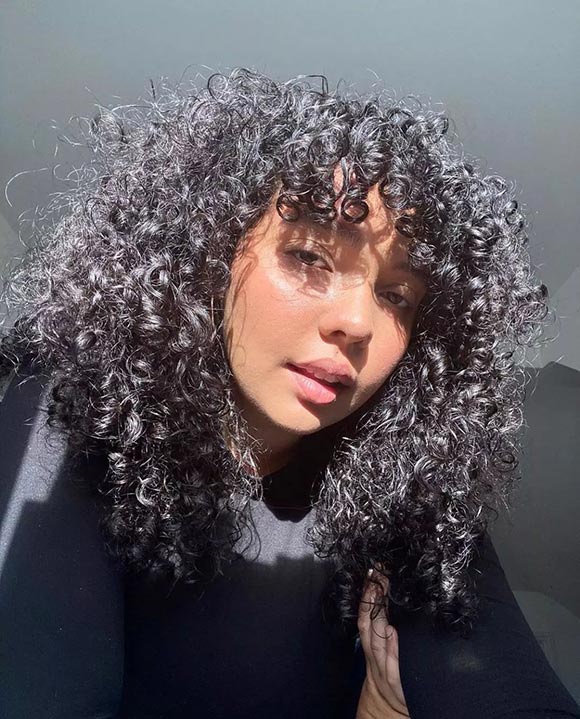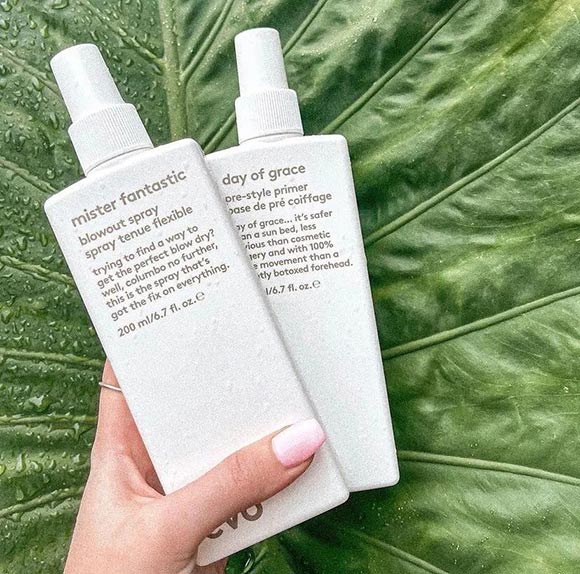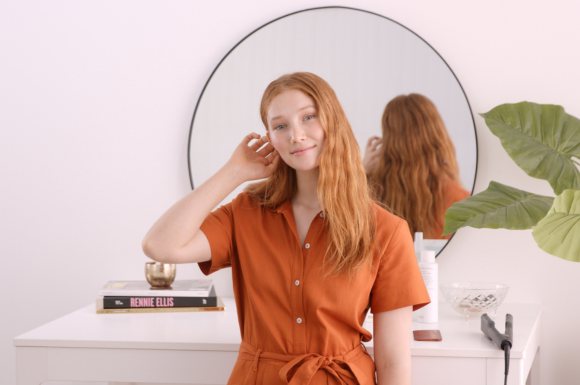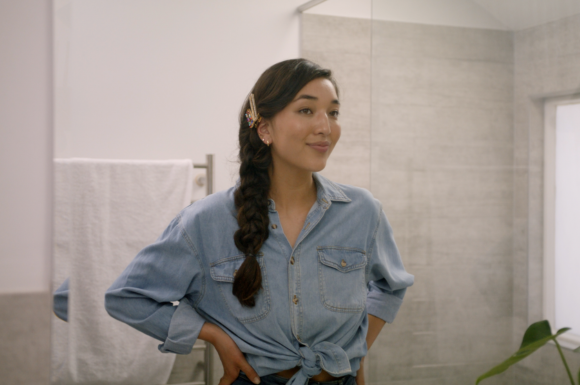
is there anything better than just-walked-out-of-the-salon hair? you know, when your cut is fresh and the blow-dry has left your hair feeling bouncy, shiny and just right.
while a new doo can’t stay picture-perfect forever, it should (usually) last a few weeks. if your dreamy hair turns dull, frizzy or limp after a few washes, you might need to rethink your hair care routine.
here’s how to start a hair care routine from scratch.
understand your hair type
before we can launch into the fun part (choosing products) let’s do the prep-work. for starters, what kind of hair type are you working with? if you don’t already know, now is the time to find out.
understanding your hair type forms the backbone of a good hair care routine. why? well, this is how we choose the right products for you and not joe from the sandwich shop down the road.
some of the most common hair types include:
curly
here’s the thing about curls: from loose waves to spirals or coils, each and every curl is unique. however, the hair community breaks curls down into types:
- type 2 hair = wavy
- type 3 hair = curly
- type 4 hair = coily
from there, each type is further broken down into sub-types, such as 2a, 2b, 2c, and 3a, 3b, 3c… you get the point.
if your hair fits into more than one of these categories, that’s completely normal. it's common, actually.
 image credit: @craphairclub @laundryldn
image credit: @craphairclub @laundryldn
dry
if your hair is dry, that usually means it’s dehydrated, low on moisture and might have lost its shine. dry hair can also show up in the form of split-ends, flyaways and breakage, or even a dry, flaky scalp.
damaged
use heat tools on the reg? over-brush your mane? sometimes skip out on conditioner? whatever the cause, damaged hair can lead to split ends, brittle texture and excessive knots or tangling.
colored
this one’s for the chameleons… think: hair that has been colored using semi, demi or permanent hair dye to change its hue.
fine
if your hair is fine, it means the actual diameter of your hair is thin. in more practical terms, fine hair can look thin and limp, if you aren’t armed with the right products.
frizzy
sometimes, hair is naturally frizzy and sometimes, it’s a symptom of being in humid weather. it can show up as fluffy and irregular hair texture or brittle ends.
thick
thick hair is when there’s a whole lotta hair per square inch of scalp. if you have thick hair, your scalp will be barely noticeable underneath all that hair; whereas if you have thin hair, your scalp will be more visible.
oily
an oily hair type is usually the result of overactive sebaceous glands that produce too much sebum, making your hair look (unintentionally) slick and greasy.
normal
if your hair type is normal, it means that your scalp produces juuuust enough oil, so that your hair is healthy-looking and generally in pretty good nick.
blonde
bottle blonde? you’ll need to invest in the right products to keep your hair from turning brassy, dull or generally bleurgh.
get clear on your hair goals
now, let’s get clear on what we’re working towards. goals help light the path to hair glory.
might we suggest some hair goals? how about:
- added smoothness and shine
- next level volume and body
- added strength and repair
- soft, hydrated strands
- bouncy, defined curls
 image credit: @laurencoophair
image credit: @laurencoophair
how to build a hair care routine
the real question: what should my hair care routine be?
there’s no one-size-fits-all when it comes to hair; every good hair care routine is completely customised to you and your doo. however, there are a few key steps that are universal: cleanse, condition, treat, protect and style.
1. cleanse
step one: wash away the day. dirt, grime, oil and styling products can build up on your hair and scalp; this is why cleansing your hair with shampoo is so important.
how often should you wash your hair? it depends on your hair type. generally speaking, coily, dry hair only needs a wash once per week. people with fine hair or oilier scalps could benefit from shampooing three to four times a week.
pick your shampoo
- for curly or wavy hair: springsclean deep clean rinse
- for frizzy hair: mane tamer smoothing shampoo
- for dry hair: the therapist hydrating shampoo
- for damaged hair: ritual salvation repairing shampoo
- for blonde hair: evo fabuloso platinum blonde toning shampoo
- for normal or oily hair: normal persons daily shampoo
- for fine hair: gluttony volumizing shampoo
 image credit: @thehightidesalon
image credit: @thehightidesalon
2. condition
thought you could skip conditioner? think again. this step is crucial to replenish your hair’s moisture levels, detangle, seal the cuticles, and return the hair to an optimal ph.
failing to use conditioner can leave your hair dry, knotty and prone to breakage – so just do it, promise?
pick your conditioner
- for curly or wavy hair: baby got bounce curl treatment
- for frizzy hair: mane tamer smoothing conditioner
- for dry hair: the therapist hydrating conditioner
- for damaged hair: ritual salvation repairing conditioner
- for blonde hair: evo fabuloso platinum blonde color boosting treatment
- for normal or oily hair: normal persons daily conditioner
- for fine hair: bride of gluttony volumizing conditioner
3. treat
sometimes, your locks just need a little bit… more. y’know, more moisture, more hydration, more smoothing, more tlc. that's where a treatment comes in. regular hair treatments can target specific concerns and improve the overall appearance and health of your mane.
pick your treatment
- for dry hair: the great hydrator moisture mask
- for damaged hair: mane attention protein treatment
- for frizzy, unruly hair: lockdown smoothing treatment
- for weak, brittle, colour-treated hair: happy campers wearable treatment
- for a colour boost: evo fabuloso range
 image credit: @hue_artisansofhair
image credit: @hue_artisansofhair
4. protect
some like it hot and if you’re partial to heat styling your hair, you’re going to need a heat protectant to prevent damage, so that your hair doesn’t sizzle.
wondering what to use to protect hair from heat damage? simply spritz one of these products all-over before blow drying or picking up the heat tools.
pick your heat protectant
- for straight-up heat protection: icon welder heat protection spray
- for heat protection with a side of conditioning: day of grace pre-style primer
- for the perfect blow-dry: mister fantastic blowout spray
- for a smooth, frizz free doo while protecting against heat: easy tiger smoothing balm
 image credit: @izzystryhairstyling
image credit: @izzystryhairstyling
5. style
the sky is the limit when it comes to styling. if you want to build volume, add texture, hold, smoothness or added shine, you’ll need a few key products to help get you (and your hair) there.
pick your styling products
- for defined curls: liquid rollers curl balm
- for beachy waves: salty dog salt spray
- for a quick second-day refresh: water killer dry shampoo
- for flexible hold: miss malleable flexible hairspray
- for rough texture and body building: box o' bollox texture paste
- for volume that starts at the root: root canal volumizing spray
- for so much more: check out evo’s styling range
 image credit: @hightrashhair
image credit: @hightrashhair
the takeaway
once you understand your hair type and hair goals, building a haircare routine is a matter of one (cleanse), two (condition), three (treat), four (protect), five (style). while every person and every mane is different, these steps will help keep your hair in tip-top shape. go forth and prosper.

